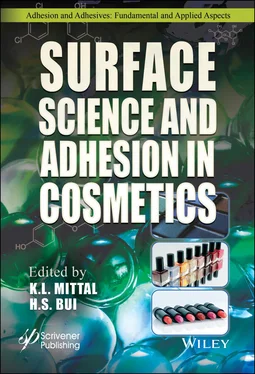1.3 In Vitro Evaluation Methods for Lipsticks
Throughout the development of a lipstick product, in vitro performance analysis is conducted in order to develop and optimize the best-performing product to be launched in market. Typically, both standardized and productspecific characterization tests are conducted in order to properly rank formulations and identify product weaknesses. Formulation characterization tests can be conducted by applying the formulation onto lips, skin, artificial skin, or glass, depending on the test method being used. This section shall provide a brief overview as to the types of tests available and used in the development of lipstick formulations, more specifically for long-wear lipstick formulations.
1.3.1 Stability Testing of Lipstick Formulations
It is important to note that the priority in lipstick development is product stability. Not only does stability impact product performance, but it can also directly influence consumer perception of the brand. Stability testing is typically conducted for different time periods at varying temperatures at which samples are observed. Common observations may include lipstick sweating, in which the oil within the formulation forms visible droplets on the exterior of the formulation, in addition to discoloration, crystallization, separation, or cracking. A Design of Experiment can be utilized during lipstick formulation stages in order to identify the best optimized formulation that passes stability testing. Currently, there is no in vitro method to predict a formulation performance in regards to stability. Therefore, utilizing a Design of Experiment is the best way to identify the optimal formulation within a particular batch.
Stability testing is conducted by placing formulation samples in a controlled environment for a specified period of time in order to relate to shelf-life and consumer environments in which the finished product may be stored. This indicates what effects different temperatures and humidity levels might have on the product following a certain time frame. Initial stability tests are carried out in a 25°C chamber and samples are observed for signs of degradation or separation at particular time points [54]. According to a patent issued to L’Oreal, inspections for this initial stability testing are done at 24 hours, 3 days, 1 week, 2 weeks, 4 weeks, and 8 weeks, and the sample is observed for phase separation, bending, sweating, and other physical conditions [54]. Once a formulation passes this stage, a second stability test is conducted for 8 weeks in varying temperature chambers in addition to a freeze-thaw condition. Such temperatures disclosed in a patent issued to L’Oreal include 37°C, 40°C, 45°C, and 50°C [54].
Stability testing of long-wear lipstick formulations is especially important due its volatile solvent component. Isododecane, which has a flashpoint of 45°C, constitutes nearly half of the volatile solvents in both the liquid and stick forms of long-wear lipstick. Therefore, the stability readout at 45°C is crucial in identifying and optimizing potential formulations. In the liquid format, should the volatile solvent flash off and fail stability, there would be an increase in viscosity; meanwhile, the stick would become dry. The packaging design and seal of such formulations is also tested through stability to help identify any loss of volatile solvent over time. Should a formulation pass these stability tests, further formulation characterization will be conducted through the use of in vitro test methods and consumer studies.
1.3.2 Physical Properties of Lipstick Formulations
1.3.2.1 Lipstick Hardness and Deposition
Lipstick hardness helps provide some insight as to the stability of lipstick for throughout the product lifecycle, from manufacturing to transportation, use and eventual end of use [55]. Hardness can be measured according to two common ASTM methods: ASTM D-1321 and ASTM D-937. These methods utilize needle penetration and cone penetration, respectively, in order to calculate formulation firmness in a quantifiable measure [56, 57]. Previous studies have indicated the use of a texture analyzer using a 500N load cell, needle penetration of 3.6 mm, velocity of 1 mm s -1, and a trigger force of 0.05N [58]. Although this method is able to provide some quantitative data, it lacks in its relation to product performance when in use by consumers. Human panels are typically used in order to subjectively assess the residual left on the lips and product feel after application. Because this value is subjective, it is subject to change and result in reproducibility issues, making it even more difficult to correlate lipstick hardness with customer satisfaction and performance. In efforts to alleviate this issue, a method and apparatus has been developed to better correlate hardness and deposition to user experience. This method studies different deposition rates of semisolid lipsticks when applied to a substrate under controlled conditions and relates the drag and deposition to consumer experience [59]. It is claimed that the results from this method relate to the consumers ‘mouth feel’ through the relation of consumer preference in terms of lipstick coverage with the deposition accomplished by the invented apparatus [59]. As a result, this creates an in vitro method which better correlates with results from human panels.
Hardness testing is only conducted for formulations that are in the stick format. In long-wear lipstick formulations, the isododecane acts as a good solvent for polyethylene wax; this wax is used to help soften the stick and is difficult to crystallize. These long-wear lipstick sticks, such as Revlon ColorStay and Maybelline SuperStay Ink Crayon Lipstick, are made slim to keep the stick softer without compromising ease of application and preventing breakage of the stick. Should a stick be wide and kept soft, it would not be able to support the stress of application and would be easy to break. Additionally, sticks with a larger diameter enable more evaporation of the volatile solvent due to its larger surface area, making the formulation tacky. In the hardness testing described above, a slim stick should have a readout of 70-100 gForce hardness, making it ideal to deposit a coating onto the lips that is not too thick.
1.3.2.2 Lipstick Wear Assays
1.3.2.2.1 Adsorption by Contact Angle Measurements
Adsorption testing of lipsticks provides an understanding of how oil and saliva adsorb onto the lipstick film over a period of time by looking at the spreading and wetting on the formulation sample. Such testing requires the use of a tensiometer, which is a machine used to measure the surface tension of liquids by dropping the liquid of interest (in this case olive oil or saliva) onto the film surface in the form of a sessile drop. This provides us with an idea of how resistant to oil or liquid the formulation may be; if there is a low value for the contact angle (Θ), the film surface is considered to be highly wetting. When the drop placed is water and the formulation has a contact angle greater than 90°, it is hydrophobic; a value less than 90° indicates the formulation has an affinity with water and can be characterized as hydrophilic. A contact angle less than 90° when testing with oil indicates the formulation is lipophilic and has an affinity with silicone.
1.3.2.2.2 Rub Test with Oil and Water
This test method is commonly used in order to determine a lipstick’s durability in regards to oils and water. Should a consumer eat greasy foods, the lipstick will become tacky or removed from the lips. In this case, the oil in the greasy food essentially acts as a make-up remover and breaks down the formulation. While resistance to grease is improved through the use of the MQ resin, products on the market today are not yet producing satisfactory outcomes when interacting with such oils. In vitro tests can be used to help predict the formulation resistance to such oils. Lipstick formulation is drawn down with 25 micrometer draw down bar on BIOSKIN, which is a urethane elastomer that is made to resemble human skin[60]. This substrate is commonly used to evaluate cosmetics due to its similarity, in terms of resiliency and feel, to human skin. The drawn down sample is left to dry at 37°C and 35%RH. In order to test oil resistance and waterproof qualities, a droplet with a controlled quantity of oil and water is then placed on the sample for ten minutes; after this point, the sample is manually wiped with a Kimwipe fifteen times, and a visual inspection is made in regards to the quality of the sample after wiping. The formulation passes the assay if there is no visual removal of the formulation after wiping with the Kimwipe. Figure 1.6(left) shows what is considered to be a good and a bad sample after the test is completed. This method correlates to the challenges associated with eating and drinking in regards to lipstick durability. Long-wear lipstick formulations should have no removal after being wiped as no formulation should transfer.
Читать дальше












